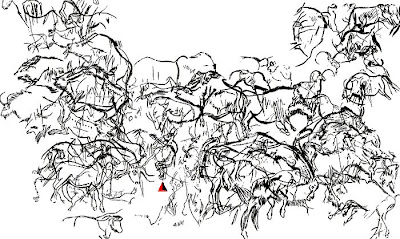
[The Musical-Bow Shaman (above red arrow), surrounded by animals, in the Three Brothers Cave, France]
The Cave of the Trois-Frères is one of the famous caves

in southwestern France known for its cave paintings.

It is located in Montesquieu-Avantès, in the Ariège département.

[Volp River region, summer view]
The cave is part of a single cave-complex with the Tuc d'Audoubert, both galleries formed by the Volp River.
The cave art has been variously dated from 18,000 to 13,000 BC.
The location is named for the three sons of Comte Bégouen who discovered it in 1910. The drawings of the cave were made famous in the publications of the Abbé Henri Breuil.

The musical bow, thought to be depicted here, is a simple string instrument (chordophone) consisting of a string supported by a flexible string bearer, usually made out of wood. Often, it is a normal archery bow used for music rather than as a weapon.

Although the bow is now thought of as a weapon, it is not clear whether it was used in this way originally. Musical bows are still used in a number of cultures today, almost all over the world.
[South Africa - Flutes and Musical Bow (c. 1950)]
A Botswana musical bow (and an aerial aerophone/idiophone) can be found at 8:11 in The Gods Must Be Crazy.
The usual way to make the bow sound is to pluck the string, although sometimes a subsidiary bow is used to scrape the string, much as on a violin.
The most usual type of resonator consists of a gourd attached to the back of the string bearer. The bow may also be stood in a pit or gourd on the ground, or one end of it may be partially placed in the mouth. This last method allows the size of the resonator to be varied as the instrument is played, thus allowing a melody of notes produced by the changing resonances produced by the player's mouth.
***

A chordophone is any musical instrument which produces sound primarily by way of a vibrating string or strings stretched between two points. It is one of the four main divisions of instruments in the original Hornbostel-Sachs scheme of musical instrument classification.
What most westerners[citation needed] would call string instruments are classified as chordophones, violins, guitars, lyres, harps, for example. However, the word also embraces instruments that many westerners would hesitate to call string instruments, such as the musical bow and the piano (which, although sometimes called a string instrument, is also called a keyboard instrument and a percussion instrument).
Hornbostel-Sachs divides chordophones into two main groups: instruments without a resonator that is an integral part of the instrument (which have the classification number 31); and instruments with such a resonator (which have the classification number 32). Most western instruments fall into the second group, but the piano and harpsichord fall into the first.
Hornbostel and Sachs' criterion for determining which sub-group an instrument falls into is that if the resonator can be removed without destroying the instrument, then it is classified as 31. The idea that the piano's casing, which acts as a resonator, could be removed without destroying the instrument, may seem odd, but if the action and strings of the piano were taken out of its box, it could still be played. This is not true of the violin, because the string passes over a bridge located on the resonator box, so removing the resonator would mean the strings had no tension.
Electric string instruments most of the time have an electromagnetic pickup with which the sound can be amplified. The Electric guitar is the most famous example, but there are new instruments like the overtone koto who make use of the new possibilities the pickupaddition offers.
Chordophones make their sound when a stretched string vibrates. There is usually something that makes the sound reverberate such as the body of a guitar or violin. The strings are set into motion by either plucking (like a harp), strumming (like a guitar) or by rubbing with a bow (like a violin or cello). Some common chordophones are the banjo, the dulcimer, the fiddle, the guitar, the harp, the lute, the piano, the ukulele, the viola and the violin.
***

To notate music with changing pitches, a treble-cleff staff can be utilized, with some of the lines and spaces identified as above.
 Typically, rhythmic values will be placed on the staff, to be interpreted as various letter-name pitches (in this case, quarter notes).
Typically, rhythmic values will be placed on the staff, to be interpreted as various letter-name pitches (in this case, quarter notes). The C major scale is a particularly important collection of notes in Western music, and the notation on the staff (now in whole notes) corresponds to piano notes as given.
The C major scale is a particularly important collection of notes in Western music, and the notation on the staff (now in whole notes) corresponds to piano notes as given.
This same scale can also be identified with Arabic numerals, showing the distance from the lowest note (the "1," "key-note," or "tonic") to any note above.

Solfege syllables (do-re-mi) -- familiar to many from Richard Rodgers's The Sound of Music,

and originally developed by Guido d'Arezzo (991-1033, on left, with aristocratic pupil to right) in his

Hymn to St. John (Ut Queant Laxis), where each phrase, like the Richard Rodgers song, starts on the next pitch level up.
Somehow over the years the "Ut" changed to "Do" (it had something to do with another sight-singing system that used the first syllable of "domine") and "Ti" was added (to this day, the French sing "Si").

The C Major scale can be sung to the solfege syllables as indicated.

Another way to remember the spaces and
 [others have been known to say, ..."deserves favor" or "fudge"...]
[others have been known to say, ..."deserves favor" or "fudge"...]lines in treble clef is given above -- however, it is recommended that one simply know the notes so well that their letter names instantly come to mind.
***
The tonic is the first note of a musical scale, the pitch upon which all other pitches of a piece are referenced.
***
In music, a melody (Greek- melōidía, "singing, chanting"), also tune, voice, or line, is a series of linear events or a succession, not a simultaneity as in a chord (see harmony). However, this succession must contain change of some kind and be perceived as a single entity to be called a melody. Most specifically this includes patterns of changing pitches and durations, while most generally it includes any interacting patterns of changing events or quality. "Melody is said to result where there are interacting patterns of changing events occurring in time."
Change is necessary for events "to be understood as related or unrelated." Melodies often consist of one or more musical phrases, motifs, and are usually repeated throughout a song or piece in various forms. Melodies may also be described by their melodic motion or the pitches or the intervals between pitches (predominantly conjuct [smooth] or disjunct [jumpy] or with further restrictions), pitch range, tension and release, continuity and coherence, cadence, and shape. "
The essential elements of any melody are duration and pitch.
[1994 Berbers in Algeria / 1990 France Chordophones Pitch / 1988 Senegal]
